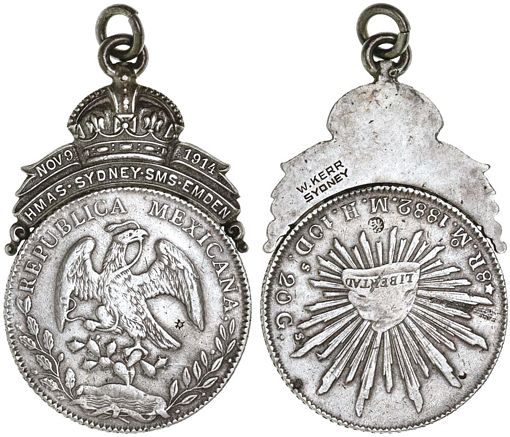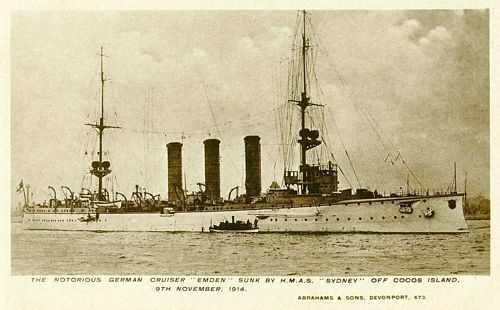The Sydney Emden Medal
by Ralf Böpple
 This is a commemorative medal issued in 1918 by the Australian Navy Board in remembrance of the naval battle of HMAS Sydney with the German light cruiser SMS Emden.
This is a commemorative medal issued in 1918 by the Australian Navy Board in remembrance of the naval battle of HMAS Sydney with the German light cruiser SMS Emden.

SMS Emden formed part of the German East Asiatic Squadron early in World War I. It stalked Indian Ocean shipping routes and became the scourge of Allied naval ships. Between August and October 1914 it captured or sank 21 vessels. The following month nine Allied vessels were involved in the hunt for the Emden, and an escort of four warships was allocated to the first Australian and New Zealand troop convoy.

On 9 November one of these escorts, HMAS Sydney, surprised the Emden while it was attacking the British radio station on the Cocos (Keeling) Islands, about 1,350 miles to the northwest of the Australian continent, and badly damaged it. The Emden was deliberately run aground. The Emden lost 134 killed and 65 wounded; the Sydney lost 4 killed and 12 wounded. The remaining Germans escaped under cover of darkness.

German soldiers were paid in Mexican dollars in Tsing-tao, and also, for its travels between Chinese and East Asian ports, the Emden carried this type of specie as means of payment in its cash box. It is reported that the captain of a Norwegian ship was paid 100 Mexican dollars for the transport of the crew of an English ship which was intercepted and scuttled a few days before to a safe haven. On the Emden, a safe filled with Mexican dollars was reportedly still on the ship three months after the battle.
According to sources, 6,429 pieces were taken from the Emden, of which 1,000 were mounted as medals. This work was carried out in 1918 by the Sydney jeweller W. Kerr, whose stamp is found on the reverse. These medals were presented by Captain John Glossop of HMAS Sydney to the members of the ship who were on board during the engagement. Others were given to naval dignitaries, the staff on Cocos Islands, and museums. The remainder was sold to the public. Of the unmounted coins, 653 were distributed by the Department of Navy, 343 were sold to the public, and the remainder was melted for the Royal Australian Navy relief fund.
On the medals given to the crew, the name and the rank of the seamen were engraved on the back of the mount. Most medals I have seen are not named, however, and considering the rarity of the medal, I am not sure that all 1,000 were indeed distributed. Additionally, it is very difficult to locate the unmounted Mexican dollars today. Apparently, they have not been specially marked, so they can only be identified by the accompanying letter from the Department of Navy with which they were sold.
Since many museums have gone online with their holdings, it is quite easy to find pictures on the internet by searching for Sydney Emden Mexican Dollar. All the pieces used in the Sydney Emden medals that I have seen show a certain number of chopmarks, which is to be expected from coins that circulated for years or decades in East Asia. Actually, the item in my collection is one of the least chopped, with the coin being a good Extremely Fine. Other coins show heavier wear or have even been cleaned.
This is a highly intriguing numismatic item, a fascinating piece of Mexican-German-Australian history, a living example of the important role of Mexican silver in world trade and commerce, and, last but not least, most likely one of a very few chopmarked condecorations!
